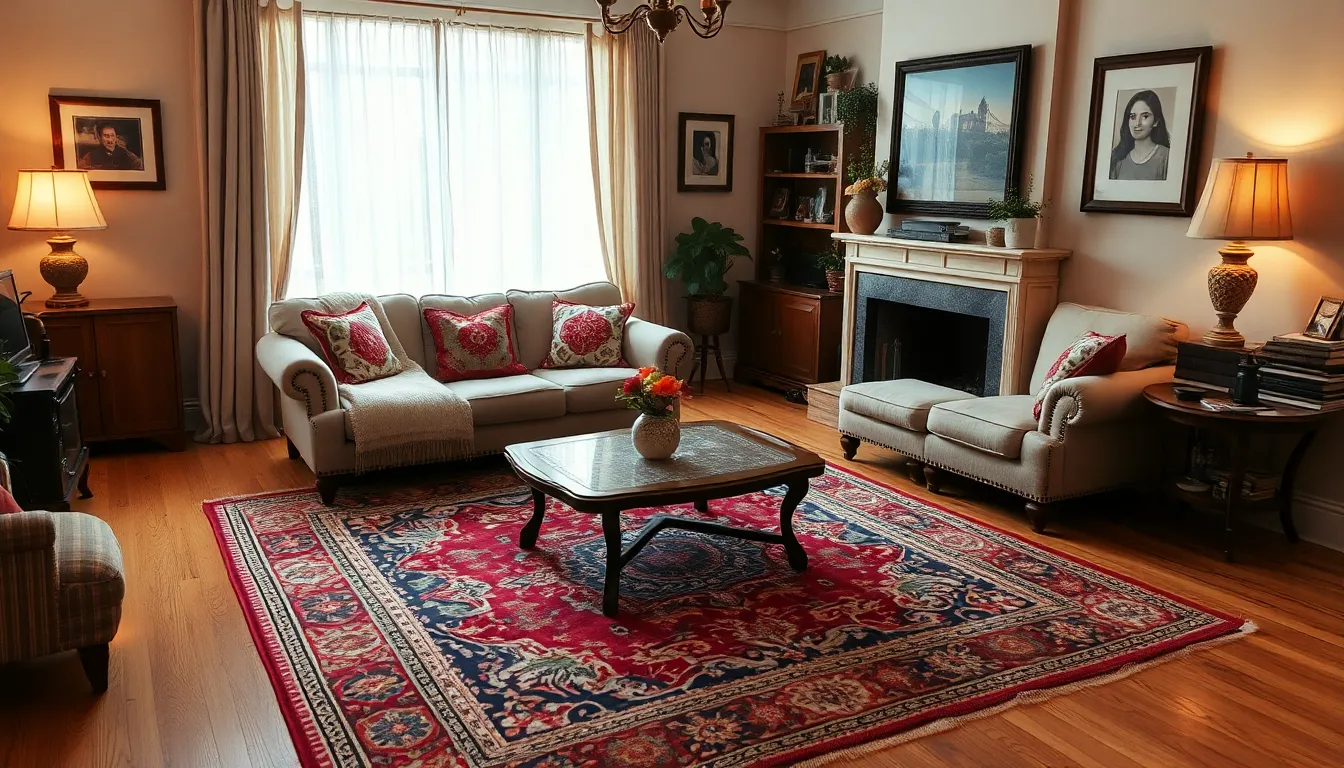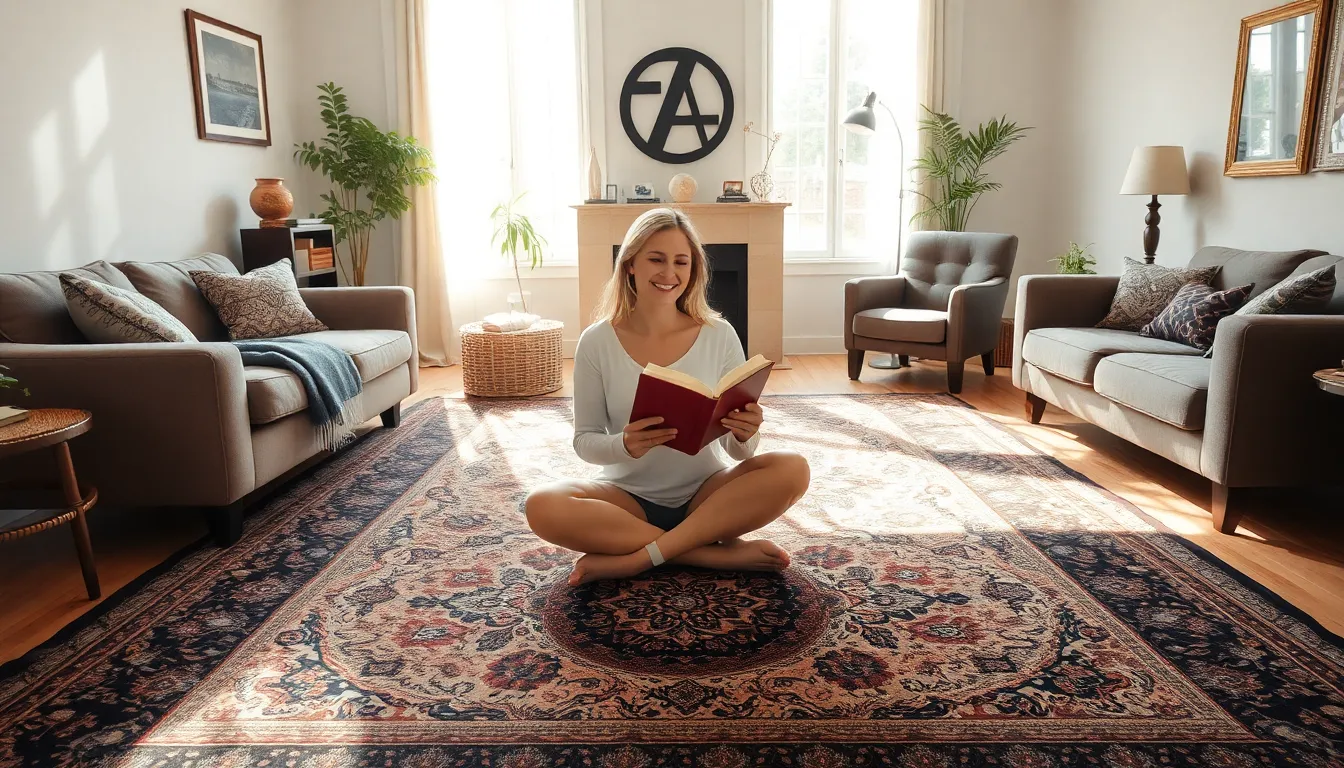Decorative rugs are more than just floor coverings; they’re the unsung heroes of home decor. Imagine walking into a room where the floor looks as bare as a cat on a diet. Not exactly inviting, right? A well-placed rug can transform that drab space into a cozy oasis, adding warmth and personality faster than you can say “where’d I put my socks?”
These versatile pieces do wonders beyond aesthetics. They can define areas, absorb sound, and even hide those little accidents that happen when friends visit. Plus, let’s be honest—who doesn’t love the feeling of sinking their toes into a plush rug after a long day? So, whether you’re sprucing up your living room or creating a zen corner, decorative rugs are the stylish sidekick your home never knew it needed. Ready to roll out the red carpet?
Table of Contents
ToggleOverview of Decorative Rug Use
Decorative rugs serve multiple purposes in home decor beyond merely covering floors. They enhance warmth and add personality to a space, transforming it into an inviting environment. Well-placed rugs define separate areas within a room, creating functional zones while maintaining an open feel.
Practical benefits of decorative rugs include noise absorption. Rugs can soften sounds, making a home quieter and more peaceful. These floor coverings also conceal minor messes, providing an easy way to maintain a tidy appearance.
Various styles and materials cater to different tastes, ensuring that each rug can complement existing decor. Natural fibers like wool and cotton offer durability and comfort, while synthetic options provide easy maintenance. Vintage or contemporary designs can achieve specific aesthetics, allowing for personalization in each room.
Rugs can guide the eye, drawing attention to key furniture pieces or artwork within the space. Incorporating multiple rugs can enhance visual interest, providing texture and depth. Layering rugs creates a unique look, combining patterns and colors harmoniously.
Choosing the right size is crucial for maximizing functionality. A proper fit allows a rug to anchor furniture, establishing a cohesive layout. Colors and patterns should align with the room’s theme, achieving a balanced and appealing atmosphere.
Decorative rugs are essential components in home decor. They contribute warmth, functionality, and style, enhancing overall living experiences. When thoughtfully selected and placed, these rugs elevate any space, making it feel truly complete.
Benefits of Decorative Rugs

Decorative rugs serve multiple purposes in enhancing home environments. They not only add beauty but also offer various practical advantages.
Aesthetic Appeal
Visual impact significantly improves with the addition of decorative rugs. Rugs introduce color and texture, creating focal points within rooms. Each design option, from intricate patterns to minimalist styles, contributes to personal expression. Homeowners can select rugs that align with existing decor or introduce new themes effortlessly. Complementing furniture with thoughtfully chosen rugs creates visual harmony. Additionally, rugs can transform a space, enhancing its overall atmosphere and inviting warmth.
Comfort and Warmth
Comfort levels increase with decorative rugs underfoot. Soft fibers cushion steps while reducing fatigue during long periods of standing or walking. Rugs can also insulate against cold surfaces, making spaces more inviting during colder months. Essential comfort in living rooms and bedrooms often comes from plush, cozy materials like wool or shag. Children appreciate safety when playing on soft surfaces, while pets enjoy comfort too. Incorporating rugs enhances warmth, allowing households to enjoy their gathering spaces year-round.
Types of Decorative Rugs
Decorative rugs come in various types, each serving distinct purposes and enhancing different aspects of home decor. Understanding these types can help in selecting the right piece for any space.
Area Rugs
Area rugs are sizable pieces that cover a portion of the floor, often used to define spaces or enhance decor. They can anchor furniture arrangements, creating a cohesive look in living rooms and dining areas. With various sizes, shapes, and designs, area rugs allow for creativity in layout and style. They also introduce warmth and texture to hard flooring, making rooms feel more inviting. Common materials include wool, cotton, and synthetic fibers, catering to diverse tastes and practical needs. Vibrant colors and patterns can act as focal points, drawing attention and setting the tone for the space.
Runners
Runners are narrower rugs that typically adorn hallways, entryways, or kitchen paths. These elongated rugs add both style and functionality to transitional areas, guiding foot traffic while protecting floors. Depending on material, such as jute, nylon, or polyester, runners can be durable and easy to maintain. Their variety of designs ensures they can complement existing decor or introduce unexpected accents. Runners contribute to a welcoming atmosphere, making spaces feel less stark and more cohesive. Properly placed, they can enhance the overall aesthetic of a home while offering practical benefits like slip resistance.
Choosing the Right Decorative Rug
Choosing a decorative rug involves careful consideration of size, shape, and material to ensure it complements the space effectively.
Size and Shape Considerations
Selecting the right size shapes how a room feels and functions. Measure the space before purchasing to avoid overcrowding or gaps. Area rugs often suit larger rooms, while runners fit narrow hallways or entryways. A general rule suggests leaving 12 to 18 inches of bare floor around the edges of the rug to create a polished look. Aligning the rug with furniture emphasizes unity. For smaller areas, opt for accent rugs that define specific zones, invoking warmth.
Material and Durability
Material significantly influences a rug’s appearance and longevity. Natural fibers like wool offer durability and comfort. They resist dirt and stains, making them ideal for high-traffic areas. Synthetic options, such as nylon or polypropylene, prove sturdy and easy to clean, perfect for homes with kids or pets. Consider the rug’s texture as well; plush surfaces provide extra comfort underfoot, especially in living rooms and bedrooms. Regular maintenance, such as vacuuming, extends the life of any rug, ensuring it remains a stylish addition.
Placement Tips for Decorative Rugs
Placement significantly impacts the effectiveness of decorative rugs in enhancing a space. Proper positioning helps define areas, create warmth, and maintain style.
In Living Spaces
Living spaces benefit greatly from carefully placed decorative rugs. Area rugs can anchor furniture arrangements, unifying seating areas and making rooms feel cozier. For instance, using a rug large enough to fit under sofas and chairs ensures that all pieces relate to each other. Additionally, layering rugs adds texture and visual intrigue, creating an inviting atmosphere. Colorful designs draw attention and can tie together various decor elements, reflecting the homeowner’s unique style.
In Bedrooms and Hallways
Bedrooms and hallways require thoughtful rug placement for optimal effect. In bedrooms, a plush rug near the bed offers comfort underfoot, enhancing the sense of relaxation. Selecting a rug that extends beyond the bed’s edges establishes a cohesive look. Hallways benefit from runners that add style while also providing practical benefits. Runners improve safety by reducing slips and falls, all while guiding guests through the space. Choosing a rug that complements existing colors or patterns ensures a seamless transition from one area to another.
Decorative rugs play a vital role in transforming spaces while providing comfort and functionality. By carefully selecting the right size and material, one can enhance the overall aesthetic of a room and create a welcoming atmosphere. Whether it’s an area rug that defines a living space or a runner that adds style to a hallway, these versatile pieces contribute significantly to home decor.
Incorporating decorative rugs allows for personal expression, introducing color and texture that complement existing furnishings. With thoughtful placement and layering, they can elevate a space, making it more inviting and visually appealing. Ultimately, decorative rugs are not just accessories but essential elements that enrich living environments, blending style with practicality.



